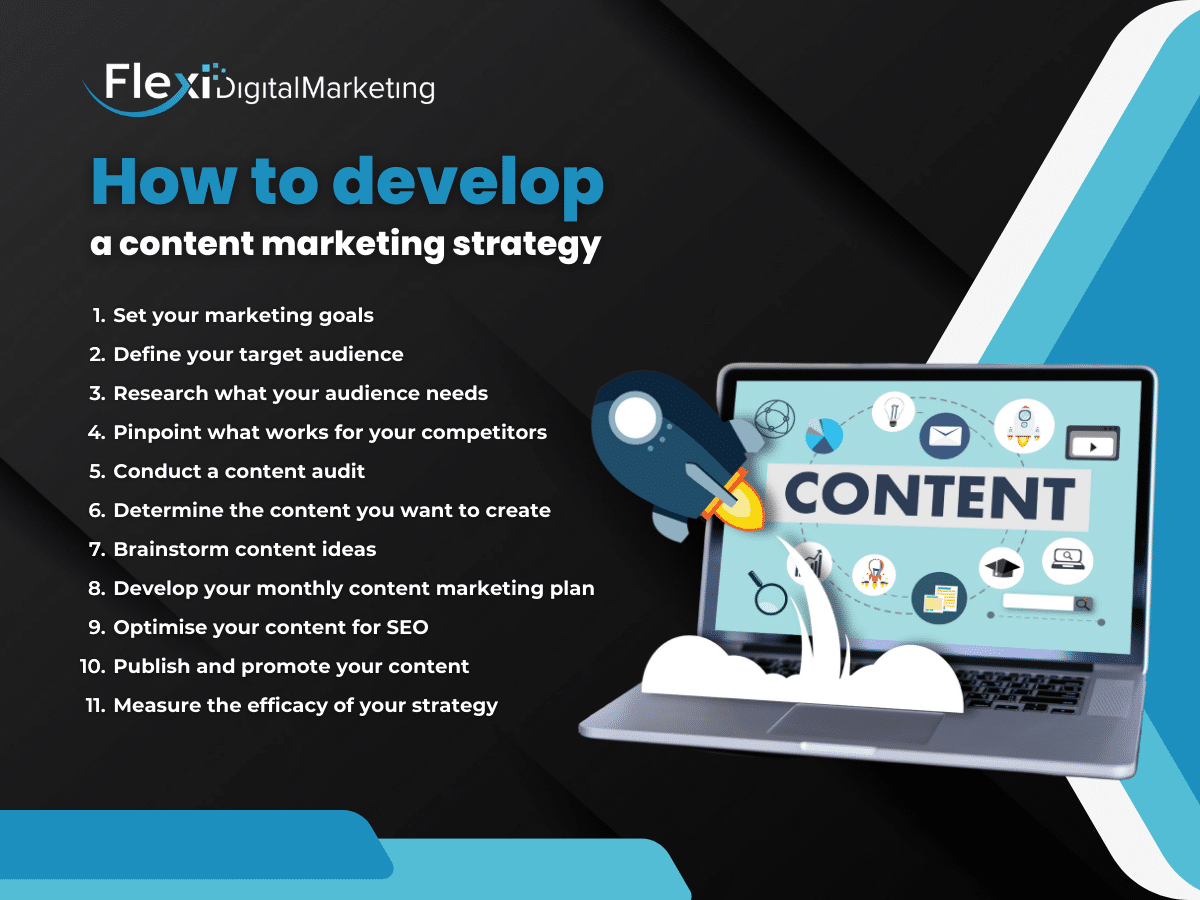There is no one-size-fits-all when it comes to content marketing. Just like online shopping, you need to carefully assess what works and what does not work for you. The good news is you can follow a content strategy guide so you can develop your own.
Likewise, in this article, we are sharing a step-by-step content strategy guide, a list of the best practices you can adopt to help you stay on track, and a few more in the mix.
Why is content marketing strategy important?
A digital content strategy gives you a concrete road map of the steps you need to take to achieve your objectives and business goals.
Aside from it functioning as a road map, there are actual benefits when you follow a content strategy guide:
One, it supports business goals. To be specific, it is at this point where your objectives take form and become something that you can take action on.
Two, it tracks what works and what does not work. Basically, a website content strategy enables you to identify the areas that you can improve on and what needs to be leveraged.
Three, it ensures high-quality content is consistently published. Aside from identifying your content and copywriting needs, a digital content strategy makes it easier for you to map out and schedule all the content you need to produce.
Before you jump to strategising, here are a couple of content strategy guide questions you should ask yourself and your marketing team first:
- Who will be reading your content?
- What problem will your content be solving?
- What makes your brand stand out?
- What content formats will you focus on?
- What channels will you use?
- How will you manage content creation and publication?
How to develop a content marketing strategy
There are a lot of content planning templates and content marketing strategy examples available online. But, as we mentioned before, a website content strategy is not a one-size-fits-all plan. Instead, we put together this step-by-step guide that you can always go back to and check whenever you need it.
Set your marketing goals
Determining what you want to achieve with your strategy is easy enough. In fact, chances are, the following goals are already some of the things you already have on your list:
- Increase organic traffic
- Increase the number of leads
- Improve conversion rates
- Improve brand awareness
- Increase overall revenue
However, it would be better to get clear-cut with your goals instead of just general objectives. A way to do that is SMART goal setting: Specific, Measurable, Achievable, Realistic, and Time-Bound.
Essentially, you set SMART goals to achieve your objectives. It is a breakdown of the targets you want to achieve within a specific timeframe.
Define your target audience
It is true that whoever has an internet connection and happens to visit your website is your audience. However, that is very broad. You need to consider who are the people that are interested in and benefit from the content you produce.
The immediate answer: Your customers. For this, it is important that you understand their lifestyle, scope of interest, problems, needs, and concerns that are relevant to your business.

Research what your audience needs
Likewise, that also includes taking the time to research the type of content your audience actually needs and wants to see. There are two ways to do this: Keyword research and user intent.
Keyword Research enables you to find the keywords and topics that your audience is most interested in.
On the other hand, User Intent implies the intention that the user has when they input a keyword or a specific query when using a search engine platform like Google. There are three types of user intent:
- Informational. The user wants to learn more about a certain topic.
- Transactional. This is when the user is looking for a specific product or service.
- Navigational. The user is looking for a specific website.
Pinpoint what works for your competitors
There are a few things that you can also learn from your competitors as well. In fact, chances are you can find aspects of their strategy that you can improve and capitalise on.
When you do this, make sure to always keep these questions in mind:
- How much organic traffic are they getting?
- What are the keywords they have the highest ranking in?
- Which sources have the most traffic?
- What are the websites that are linked to them?
- How is their content performing?
- What are the gaps you noticed in their digital marketing strategy?
- How can you capitalise on their gaps?
Conduct a content audit
This is one of the essential steps for a content strategy guide. Here, you need to take stock of all the content you have produced thus far and thoroughly assess which ones are performing quite well.
A content audit will help you get a better idea of how your website is currently faring and which aspects you need to improve or completely change to better serve your business and your goals.
Determine the content you want to create
There are plenty of content types that you can produce these days. In fact, if you have created more than one type you add more value to your web visitors and potentially increase your ranking in search engine results pages (SERPs).
Here are the popular content types you should consider creating, aside from blog posts:
- Ebooks
- Case Studies
- Infographics
- Videos
- Podcasts
- Audio Blogging
- Social Media Content
Brainstorm content ideas
This is the part where you come up with the content you want to produce based on the information you got from the steps mentioned above. To make things easier, here are a couple of tools you can use to help you out:
- BlogAbout
- BuzzSumo
- Headline Studio by CoSchedule
- Feedly
Develop your monthly content marketing plan
Now, you just have to put everything together into a content marketing plan.
You can start on a monthly basis to make it easier to track then slowly expand it into a quarterly plan and then to a yearly plan. You can also do this in reverse if that works for you. Just make sure you have the following:
- The stages of the sales funnel that each content will address.
- The format of the content that you want to produce.
- The people who are responsible for producing the content.
- The timetable for when the content will be produced and published.
- The required steps to promote the content.
Optimise your content for SEO
Let us assume you already produced the content you will publish for the next month. Just before you post it, you need to make sure that each one is properly optimised to actually perform well and rank.
Here is a checklist of elements you need to check before you publish your content:
- Make URLs short, readable, and have the primary keyword.
- Ensure the primary keyword is present for both the page title and headline.
- Add the primary keyword in the first 100 words of the content.
- Include related keywords throughout the content.
- Ensure content effectively provides answers with clear-cut explanations.
- Add links to websites with higher domain authority.
- Add links to your existing content.
Publish and promote your content
Once you have ensured that all your content is optimised, you can now publish it on your website and social media channels.
However, that is just half of it. For the other half, you need to actively promote your content. There are a lot of ways you can do this, here are a couple of tried-and-true methods you can apply:
- Social Media. Promote the content you published on your website by sharing it on your social media channels with a compelling caption and a straightforward call to action, such as “link in bio” or “click the link below.”
- Email Outreach. Reach out to your industry peers, brands, and influencers so you can tap into a relevant traffic source.
- Paid Ads. Run pay-per-click (PPC) campaigns for your published content.
- Content Syndication. Republish your article on a third-party website that has a larger audience and higher traffic to help direct it back to your published content or website.
Measure the efficacy of your strategy
Last but not least is to gather data and measure the efficacy of your content marketing strategy. This is the part where you compare the performance data you gathered to the SMART goals you set earlier.
Here are a couple of key performance indicators (KPIs) that you can use to measure your strategy:
- User Engagement. This refers to the interaction between your content and your audience such as shares, comments, likes, and even mentions.
- User Behaviour. This refers to bounce rate, page views, and time on site, to name a few.
- Organic Search Traffic. These are the web users who visit your website that is not from unpaid sources or did not click on your paid ads.
- Conversion Rate. This refers to the number of web visitors who purchased your products or subscribed to your services.
Last step of your content strategy guide: Follow the best practices
So, you learned how to do content marketing strategies. It is a lot easier since you have a step-by-step content strategy guide.
Now, you just have to make sure that it is effective and that you stay on track. A way to do this is by sticking to a couple of best practices.
Find ways to add more value to your content
The best way to compete for the top spot is to always add value. At the end of the day, you are serving your audience by effectively answering their queries and adding more relevant information that helps them.
Here are a couple of ways to add value:
- Provide tips and real-life applications.
- Add frequently asked questions (FAQs).
- Condense long-form content into bite-sized pieces such as infographics.
- Reach out to subject matter experts to give a more in-depth explanation about a certain topic.
- Add web tools that web users can use for free.
Be consistent
Consistency can help your business a lot. Just like when you set a fitness goal, it is through consistency that you will achieve results. In fact, the best content strategy examples are brands that have remained consistent.
With that said, here are the elements you should always remain consistent with your content:
- Quality
- Publishing
- Tone of Voice
- Visual Style
Leverage your analytics
One of the best strategic decisions you can make is to leverage your analytics.
You should always keep an eye on the performance of your content, website, and even on your social media channels. Find out which ones are doing the best and which ones need a boost to do better. This is a cost-effective approach that ensures a hefty return on investment (ROI).
Focus on what you can do and outsource what you cannot
Increasing content production is great. However, this can be a double-edged sword if you are not careful. Instead of just relying on your in-house staff, you can outsource some of the things you need to a digital marketing agency.
For example, you can develop a content marketing strategy and publish the content on your website. Then you can partner with a third-party digital agency to get an SEO specialist and PPC specialist.
Need help with your content strategy? Upgrade your digital marketing projects with us!


